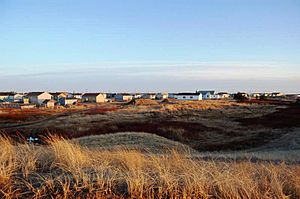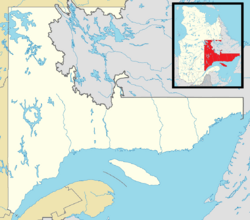Nutashkuan facts for kids
Quick facts for kids
Nutashkuan
Natashquan
|
|
|---|---|
|
First Nations reserve
|
|
 |
|
| Country | Canada |
| Province | Quebec |
| Region | Côte-Nord |
| Regional county | none |
| Formed | 1953 |
| Area | |
| • Total | 1.19 km2 (0.46 sq mi) |
| • Land | 1.35 km2 (0.52 sq mi) |
| There is an apparent discrepancy between 2 authoritative sources. | |
| Population
(2021)
|
|
| • Total | 915 |
| • Density | 678.5/km2 (1,757/sq mi) |
| Time zone | UTC−05:00 (Within the AST legislated time zone boundary but observes EST) |
| • Summer (DST) | UTC−04:00 (EDT) |
| Postal Code |
G0G 2E0
|
| Area code(s) | 418 and 581 |
Nutashkuan (also spelled Natashquan) is a special place in Canada. It is a First Nations reserve in the province of Quebec. This land belongs to the Première Nation des Innus de Nutashkuan band, who are the Innu people.
The reserve is located on the north shore of the Gulf of St. Lawrence. It sits right at the mouth of the Natashquan River. You can find it about 336 kilometers (209 miles) east of a city called Sept-Îles. Since 1996, you can reach Nutashkuan by Route 138.
It's important not to confuse this reserve with the nearby town of Natashquan. They are two separate places, even though they are close.
The community of Nutashkuan has many helpful services. These include a nursing station for health care and a local radio station. There's also a water and sewer system, a fire station, and a police force run by the Indigenous community.
The area was first mapped in 1684 by Louis Jolliet. He called it Noutascoüan. Over time, the name was spelled in many ways. It became Natashquan around 1895. In the Innu language, the name is Nutahkuant or Nutashkuan. It means "where the black bear is taken" or "where one hunts for bear."
Contents
History of Nutashkuan
For a long time, the Innu people were nomadic. This means they moved around a lot. In winter, they hunted in the forests. In summer, they moved to the coast to fish for salmon and hunt seals.
Early Trading Post
Around 1710, a trading post was set up near the Natashquan River. This was a place where people could trade furs with the Indigenous people. The Innu would gather at this post during their yearly travels. Over time, some Innu families started to live there permanently. The Hudson's Bay Company took over the post in the mid-1800s. But it was closed around 1914 because it wasn't making enough money.
Creating the Reserve
In 1909, the first survey was done to create a reserve. In 1952, the Canadian government bought some land. It was about 20.5 acres (8.3 hectares). This land was given to the Innu people on March 31, 1953. The reserve grew bigger over the years. More land was added in 1954, 1970, and 1993.
People of Nutashkuan
As of May 2022, the Innu band had 1,212 members. Most of them, 1,095 people, lived on the reserve.
Population Numbers
In the 2021 Canadian census, there were 915 people living in Nutashkuan. There were 228 homes where people lived regularly.
| Historical census populations – Nutashkuan | |||||||||||||||||||||||||||||||||||||
|---|---|---|---|---|---|---|---|---|---|---|---|---|---|---|---|---|---|---|---|---|---|---|---|---|---|---|---|---|---|---|---|---|---|---|---|---|---|
|
|
||||||||||||||||||||||||||||||||||||
| Source: Statistics Canada | |||||||||||||||||||||||||||||||||||||
Languages Spoken
The main language spoken in Nutashkuan is Innu-aimun. This is the traditional language of the Innu people.
Here's a look at the main languages spoken (2021):
- English: 0%
- French: 0.5%
- Innu-aimun: 97.8%
- French and another language: 1.1%
Climate and Weather
Nutashkuan has a subarctic climate. This type of climate is common for places along the Gulf of St. Lawrence.
Seasons in Nutashkuan
- Summers are mild and often rainy. Days are warm, but nights can be cool.
- Winters are very cold. There is a lot of snow, about 356.3 centimeters (140 inches) each year.
- The area gets about 1,900 hours of sunshine every year.
| Climate data for Natashquan Airport | |||||||||||||
|---|---|---|---|---|---|---|---|---|---|---|---|---|---|
| Month | Jan | Feb | Mar | Apr | May | Jun | Jul | Aug | Sep | Oct | Nov | Dec | Year |
| Record high humidex | 8.1 | 5.8 | 10.0 | 16.7 | 25.2 | 30.2 | 35.9 | 32.9 | 31.2 | 20.6 | 14.8 | 8.7 | 35.9 |
| Record high °C (°F) | 8.2 (46.8) |
6.7 (44.1) |
12.8 (55.0) |
17.8 (64.0) |
23.9 (75.0) |
26.4 (79.5) |
28.9 (84.0) |
28.3 (82.9) |
26.1 (79.0) |
19.4 (66.9) |
14.4 (57.9) |
9.4 (48.9) |
28.9 (84.0) |
| Mean daily maximum °C (°F) | −8.0 (17.6) |
−7.2 (19.0) |
−2.2 (28.0) |
3.4 (38.1) |
9.7 (49.5) |
15.0 (59.0) |
18.5 (65.3) |
18.2 (64.8) |
14.2 (57.6) |
8.1 (46.6) |
1.9 (35.4) |
−4.3 (24.3) |
5.6 (42.1) |
| Daily mean °C (°F) | −13.5 (7.7) |
−12.7 (9.1) |
−7.1 (19.2) |
−0.3 (31.5) |
5.5 (41.9) |
10.7 (51.3) |
14.4 (57.9) |
14.1 (57.4) |
10.0 (50.0) |
4.2 (39.6) |
−1.9 (28.6) |
−9.0 (15.8) |
1.2 (34.2) |
| Mean daily minimum °C (°F) | −19.0 (−2.2) |
−18.1 (−0.6) |
−12.0 (10.4) |
−3.9 (25.0) |
1.3 (34.3) |
6.3 (43.3) |
10.3 (50.5) |
9.9 (49.8) |
5.7 (42.3) |
0.3 (32.5) |
−5.6 (21.9) |
−13.7 (7.3) |
−3.2 (26.2) |
| Record low °C (°F) | −42.8 (−45.0) |
−37.2 (−35.0) |
−33.7 (−28.7) |
−22.5 (−8.5) |
−12.8 (9.0) |
−3.9 (25.0) |
1.1 (34.0) |
−1.1 (30.0) |
−7.8 (18.0) |
−15.0 (5.0) |
−25.6 (−14.1) |
−35.0 (−31.0) |
−42.8 (−45.0) |
| Record low wind chill | −52.3 | −47.9 | −42.9 | −31.3 | −17.9 | −15.0 | 0.9 | −3.4 | −7.3 | −19.6 | −30.4 | −46.2 | −52.3 |
| Average precipitation mm (inches) | 95.7 (3.77) |
67.4 (2.65) |
95.2 (3.75) |
81.7 (3.22) |
88.6 (3.49) |
86.2 (3.39) |
99.0 (3.90) |
96.0 (3.78) |
100.5 (3.96) |
107.9 (4.25) |
106.4 (4.19) |
105.3 (4.15) |
1,129.8 (44.48) |
| Average rainfall mm (inches) | 18.8 (0.74) |
12.5 (0.49) |
27.7 (1.09) |
47.2 (1.86) |
83.6 (3.29) |
86.2 (3.39) |
99.0 (3.90) |
97.1 (3.82) |
100.4 (3.95) |
102.2 (4.02) |
70.5 (2.78) |
29.4 (1.16) |
774.5 (30.49) |
| Average snowfall cm (inches) | 79.1 (31.1) |
55.8 (22.0) |
66.9 (26.3) |
33.3 (13.1) |
4.5 (1.8) |
0.0 (0.0) |
0.0 (0.0) |
0.0 (0.0) |
0.0 (0.0) |
5.5 (2.2) |
34.4 (13.5) |
76.8 (30.2) |
356.3 (140.3) |
| Average precipitation days (≥ 0.2 mm) | 19.1 | 15.8 | 15.7 | 14.5 | 13.9 | 13.0 | 14.3 | 13.2 | 14.3 | 15.2 | 15.1 | 17.7 | 181.9 |
| Average rainy days (≥ 0.2 mm) | 2.5 | 2.4 | 4.5 | 8.5 | 13.2 | 13.0 | 14.3 | 13.2 | 14.3 | 14.4 | 9.0 | 4.4 | 113.8 |
| Average snowy days (≥ 0.2 cm) | 18.4 | 14.9 | 13.6 | 9.3 | 1.8 | 0.0 | 0.0 | 0.0 | 0.0 | 2.2 | 9.2 | 16.1 | 85.6 |
| Average relative humidity (%) (at 06:00 / 15:00 LST) | 73.3 | 73.4 | 77.4 | 82.2 | 84.1 | 85.2 | 90.7 | 92.7 | 91.5 | 87.1 | 82.7 | 76.7 | 83.1 |
| Average afternoon relative humidity (%) (at 06:00 / 15:00 LST) | 68.8 | 67.6 | 70.4 | 73.3 | 70.5 | 71.5 | 76.1 | 77.1 | 75.6 | 73.1 | 73.2 | 71.9 | 72.4 |
| Mean monthly sunshine hours | 104.7 | 125.3 | 148.2 | 161.4 | 214.2 | 219.3 | 236.8 | 228.2 | 166.0 | 125.4 | 96.8 | 87.2 | 1,913.4 |
| Percent possible sunshine | 39.4 | 44.2 | 40.3 | 39.1 | 44.8 | 44.8 | 48.0 | 50.8 | 43.7 | 37.5 | 35.5 | 34.6 | 41.9 |
| Source: Environment and Climate Change Canada | |||||||||||||
Economy and Jobs
The economy in Nutashkuan is based on several activities. Many people work in arts and crafts, creating beautiful items.
- Traditional Activities: Trapping animals for furs is still important.
- Tourism: Visitors come to see the area's natural beauty.
- Construction and Transport: Some jobs are in building and moving goods.
- Commercial Fishing: Fishing is also a key part of the economy. The Band council, which leads the community, even owns a boat and has a license to fish for crab.
There are about 20 businesses on the reserve. The Corporation de développement économique de Natashquan helps to create new jobs and grow the local economy.
Education
Nutashkuan has one school called École Uauitshitun. This school teaches students from pre-Kindergarten up to Secondary grade 3.


